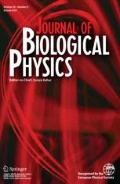Abstract
Knowledge regarding the 3D structure of a protein provides useful information about the protein’s functional properties. Particularly, structural similarity between proteins can be used as a good predictor of functional similarity. One method that uses the 3D geometrical structure of proteins in order to compare them is the similarity value (SV). In this paper, we introduce a new definition of the SV measure for comparing two proteins. To this end, we consider the mass of the protein’s atoms and concentrate on the number of protein’s atoms to be compared. This defines a new measure, called the weighted similarity value (WSV), adding physical properties to geometrical properties. We also show that our results are in good agreement with the results obtained by TM-SCORE and DALILITE. WSV can be of use in protein classification and in drug discovery.






Similar content being viewed by others
Notes
When the TM-SCORE is less than 0.2 it corresponds to randomly chosen unrelated proteins whereas with a score higher than 0.5 we generally assume the same fold in SCOP/CATH [21]. Here we normalized the TM-SCORE to 0.5 (i.e., we divided it by 2).
References
Li, B., Turuvekere, S., Agrawal, M., La, D., Ramani, K.,Kihara, D.: Characterization of local geometry of protein surfaces with the visibility criterion. Proteins 71, 670 (2008)
Rupp, B., Wang, J.: Predictive models for protein crystallization. Methods 34, 390 (2004)
Arnold, K., Bordoli, L., Kopp, J., Schwedem, T.: The SWISS-MODEL workspace: a web-based environment for protein structure homology modelling. Bioinf. (Oxford, England) 22, 195–201 (2006)
Kolodn, R., Petrey, D., Honig, B.: Protein structure comparison: implications for the nature of “fold space”, and structure and function prediction. Curr. Opin. Struct. Biol. 16, 393–398 (2006)
Carugo, O.: Recent progress in measuring structural similarity between proteins. Curr. Protein Peptide Sci. 8, 219–241 (2007)
Zhang, Y.: I-TASSER server for protein 3D structure prediction. BMC Bioinf. 9, 101186 (2008)
Betancourt, M.R., Skolnick, J.: Universal similarity measure for comparing protein structures. Biopolymers 59, 305–309 (2001)
Kihara, D., Sael, L., Chikhi, R., Esquivel-Rodriguez, J.: Molecular surface representation using 3D Zernike descriptors for protein shape comparison and docking. Curr. Protein Pept. Sci. 12(6), 520–530 (2011)
Murzin, A.G., Brenner, S.E., Hubbard, T., Chothia, C.: SCOP: a structural classification of proteins database for the investigation of sequences and structures. J. Mol. Biol. 247(4), 536–540 (1995)
Andreeva, A., Howorth, D., Chandonia, J.-M., Brenner, S.E., Hubbard, T.J.P., Chothia, C., Murzin, A.G.: Data growth and its impact on the SCOP database: new developments. Nucleic Acids Res. 36, D419–425 (2008).
Maiorov, V.N., Crippen, G.M.: Significance of root-mean-square deviation in comparing three-dimensional structures of globular proteins. J. Mol. Biol. 235(2), 625–634 (1994)
Carugo, O., Pongor, S.: A normalized root-mean-square distance for comparing protein three-dimensional structures. Protein Sci.: Publ. Protein Soc. 10(7), 1470–1473 (2001)
Orengo, C.A., Michie, A.D., Jones, S., Jones, D.T., Swindells, M.B., Thornton, J.M.: CATH—a hierarchic classification of protein domain structures. Structure (London, England: 1993) 5, 1093–1108 (1997)
Zhang, Y., Skolnick, J.: Scoring function for automated assessment of protein structure template quality. Proteins 57, 702–710 (2004)
Xu, J., Zhang, Y.: How significant is a protein structure similarity with TM-SCORE = 0.5? Bioinformatics 26, 889–895 (2010)
Levitt, M., Gerstein, M.: STRUCTAL. A structural alignment program. Stanford University (2005). Available from: http://csb.stanford.edu/levitt/Structal.
Holm, L., Ouzounis, C., Sander, C., Tuparev, G., Vriend, G.: A database of protein structure families with common folding motifs. Protein Sci. 1, 1691–1698 (1992)
Hasegawa, H., Holm, L.: Advances and pitfalls of protein structural alignment. Curr. Opin. Struct. Biol. 19, 341–348 (2009)
Saberi Fathi, S.M., White, D.T., Tuszynski, J.A.: Geometrical comparison of two protein structures using Wigner-D functions. Proteins 82, 2756–2769 (2014). doi:10.1002/prot.24640
Daniel, K.P., et al.: Reconstruction of SAXS Profiles from Protein Structures. Comput. Struct. Biotechnol. J. 8(11), e201308006 (2013). doi:10.5936/csbj.201308006
Zhang, Y., Skolnick, J.: TM-align: a protein structure alignment algorithm based on the TM-SCORE. Nucleic Acids Res. 33(7), 2302–2309 (2005). doi:10.1093/nar/gki524
Wigner, E.P.: Gruppentheorie und ihre Anwendungen auf die Quantenmechanik der Atomspektren. Vieweg Verlag, Braunschweig (1931)
Potts, D., Prestin, J., Vollrath, A.: A fast algorithm for nonequispaced Fourier transforms on the rotation group. Numer. Algorithms 52, 355–384 (2009)
Hielscher, R., Potts, D., Prestin, J., Schaeben, H., Schmalz, M.: The Radon transform on SO(3): a Fourier slice theorem and numerical inversion. Inverse Prob. 24, 025011 (2008)
Lipson, H., Taylor, C.A.: Fourier Transforms and X-ray Diffraction. Bell, London (1958)
McKie, D., McKie, C., Essentials of Crystallography, Blackwell Scientific Publications, (1992). ISBN 0-632-01574-8.
Sokolova, M., Japkowicz, N., Szpakowicz, S.: Beyond Accuracy, F-score and ROC: a Family of Discriminant Measures for Performance Evaluation, American Association for Artificial Intelligence, (2006). https://www.aaai.org/Papers/Workshops/2006/WS-06-06/WS06-06-006.pdf.
Acknowledgments
I thank Dr. Jack A. Tuszynski (University of Alberta) for his helpful comments.
Author information
Authors and Affiliations
Corresponding author
Rights and permissions
About this article
Cite this article
Saberi Fathi, S.M. A new definition and properties of the similarity value between two protein structures. J Biol Phys 42, 621–636 (2016). https://doi.org/10.1007/s10867-016-9429-0
Received:
Accepted:
Published:
Issue Date:
DOI: https://doi.org/10.1007/s10867-016-9429-0




